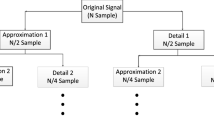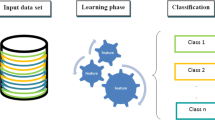Abstract
This paper presents an anomaly detection model based on normalized mutual information feature selection (NMIFS) and quantum wavelet neural network (QWNN). The goal of the proposed model is to address the problem of determining the feature subset used to detect an anomaly in a machine learning task. In order to achieve an effective reduction for high-dimensional feature data, the NMIFS method is used to select the best feature combination from a given set of sample features. Then, the best combination of feature vectors are sent to the QWNN classifier for learning and training in the training phase, and the anomaly detection model is obtained. At the detection stage, the data is fed into the detection model and ultimately generates accurate detection results. The learning algorithm of structural risk minimization extreme learning machine is employed by the QWNN classifier to account for empirical and confidence risk. The experimental results on real abnormal data demonstrate that the NMIFS–QWNN method has higher detection accuracy and a lower false negative rate than the existing common anomaly detection methods. Furthermore, the complexity of the algorithm is low and the detection accuracy can reach up to 95.8%.





Similar content being viewed by others
References
Marnerides, A. K., Schaeffer-Filho, A., & Mauthe, A. (2014). Traffic anomaly diagnosis in Internet backbone networks: A survey. Computer Networks, 73, 224–243.
Sheikhan, M., & Jadidi, Z. (2014). Flow-based anomaly detection in high-speed links using modified GSA-optimized neural network. Neural Computing and Applications, 24(3–4), 599–611.
Lin, S. W., Ying, K. C., Lee, C. Y., & Lee, Z. J. (2012). An intelligent algorithm with feature selection and decision rules applied to anomaly intrusion detection. Applied Soft Computing, 12(10), 3285–3290.
Amiri, F., Yousefi, M. M. R., Lucas, C., Shakery, A., & Yazdani, N. (2011). Mutual information-based feature selection for intrusion detection systems. Journal of Network and Computer Applications, 34, 1184–1199.
Peng, L., Zhang, H., Yang, B., & Chen, Y. (2014). Feature evaluation for early stage internet traffic identification. Algorithms and architectures for parallel processing (pp. 511–525). Berlin: Springer.
Yu, L., & Liu, H. (2004). Efficient feature selection via analysis of relevance and redundancy. Journal of Machine Learning Research: JMLR, 5, 1205–1224.
Lashkia, G., & Anthony, L. (2004). Relevant, irredundant feature selection and noisy example elimination. IEEE Transactions on Systems, Man, and Cybernetics, 34(2), 888–897.
Battiti, R. (1994). Using mutual information for selecting features in supervised neural net learning. IEEE Transactions on Neural Networks, 5(4), 537–550.
Kwak, N., & Choi, C. (2002). Input feature selection for classification problems. IEEE Transactions on Neural Networks, 13(1), 143–159.
Peng, H., Long, F., & Ding, C. (2005). Feature selection based on mutual information: Criteria of max-dependency, max-relevance, and min-redundancy. IEEE Transactions on Pattern Analysis and Machine Intelligence, 27(8), 1226–1238.
Estévez, P. A., Tesmer, M., Perez, C. A., & Zurada, J. M. (2009). Normalized mutual information feature selection. IEEE Transactions on Neural Networks, 20(2), 189–201.
Hoque, N., Bhattacharyya, D. K., & Kalita, J. K. (2014). MIFS-ND: A mutual information-based feature selection method. Expert Systems with Applications, 41(14), 6371–6385.
Li, J. (2015). Quantum-inspired neural networks with application. Open Journal of Applied Sciences, 5(06), 233.
Cover, T. M., & Thomas, J. A. (2012). Elements of information theory. New York: Wiley.
Haroutunian, E. (2011). Information theory and statistics. International Encyclopedia of statistical science (pp. 666–667). Berlin: Springer.
Shi, Y., & Mizumoto, M. (2000). Some considerations on conventional neuro-fuzzy learning algorithms by gradient descent method. Fuzzy Sets and Systems, 112(1), 51–63.
Huang, G. B., Wang, D. H., & Lan, Y. (2011). Extreme learning machines: A survey. International Journal of Machine Learning and Cybernetics, 2(2), 107–122.
Miche, Y., Sorjamaa, A., Bas, P., Jutten, C., & Lendasse, A. (2010). OP-ELM: Optimally pruned extreme learning machine. IEEE Transactions on Neural Networks, 21(1), 158–162.
He, Y. L., Geng, Z. Q., Xu, Y., & Zhu, Q. X. (2014). A hierarchical structure of extreme learning machine (HELM) for high-dimensional datasets with noise. Neurocomputing, 128, 407–414.
Zhu, Z. F., Wang, P. P., Jia, Z. P., Xiao, H. R., Zhang, G. Y., & Liang, H. (2014). A modified minimum risk bayes and it’s application in spam filtering. Frontier and future development of information technology in medicine and education (pp. 2155–2159). Berlin: Springer.
Shao, Y. H., Chen, W. J., Wang, Z., Li, C. N., & Deng, N. Y. (2015). Weighted linear loss twin support vector machine for large-scale classification. Knowledge-Based Systems, 73, 276–288.
Stolfo, B. S. (2010). KDD Cup 1999 Data. http://kdd.ics.uci.edu/databases/kddcup99/kddcup99.html
Faqhruldin, O. N., El-Saadany, E. F., & Zeineldin, H. H. (2014). A universal islanding detection technique for distributed generation using pattern recognition. IEEE Transactions on Smart Grid, 5(4), 1985–1992.
Yu, S., Tranchevent, L. C., Liu, X., & Glanzel, W. (2012). Optimized data fusion for kernel k-means clustering. IEEE Transactions on Pattern Analysis and Machine Intelligence, 34(5), 1031–1039.
Cheng, D., Zhang, S., Deng, Z., Zhu, Y., & Zong, M. (2014). kNN algorithm with data-driven k value. Advanced data mining and applications (pp. 499–512). Berlin: Springer.
Guo, Y., Li, K., & Liu, X. (2013). Fault diagnosis for power system transmission line based on PCA and SVMs. intelligent computing for sustainable energy and environment (pp. 524–532). Berlin: Springer.
Sharma, S. K., Pandey, P., Tiwari, S. K., & Sisodia, M. S. (2012). An improved network intrusion detection technique based on K-means clustering via Naϊve bayes classification. In International conference on advances in engineering, science and management, pp. 417–422
Acknowledgements
This research received grant from National Natural Science Foundation of China (Nos. 61672471, 61502436). We also supported by 2016 annual Henan technological innovation (No. 164100510019).
Author information
Authors and Affiliations
Corresponding author
Ethics declarations
Conflict of interest
The authors declare that they have no conflict of interest.
Rights and permissions
About this article
Cite this article
Huang, W., Zhang, J., Sun, H. et al. An Anomaly Detection Method Based on Normalized Mutual Information Feature Selection and Quantum Wavelet Neural Network. Wireless Pers Commun 96, 2693–2713 (2017). https://doi.org/10.1007/s11277-017-4320-2
Published:
Issue Date:
DOI: https://doi.org/10.1007/s11277-017-4320-2




